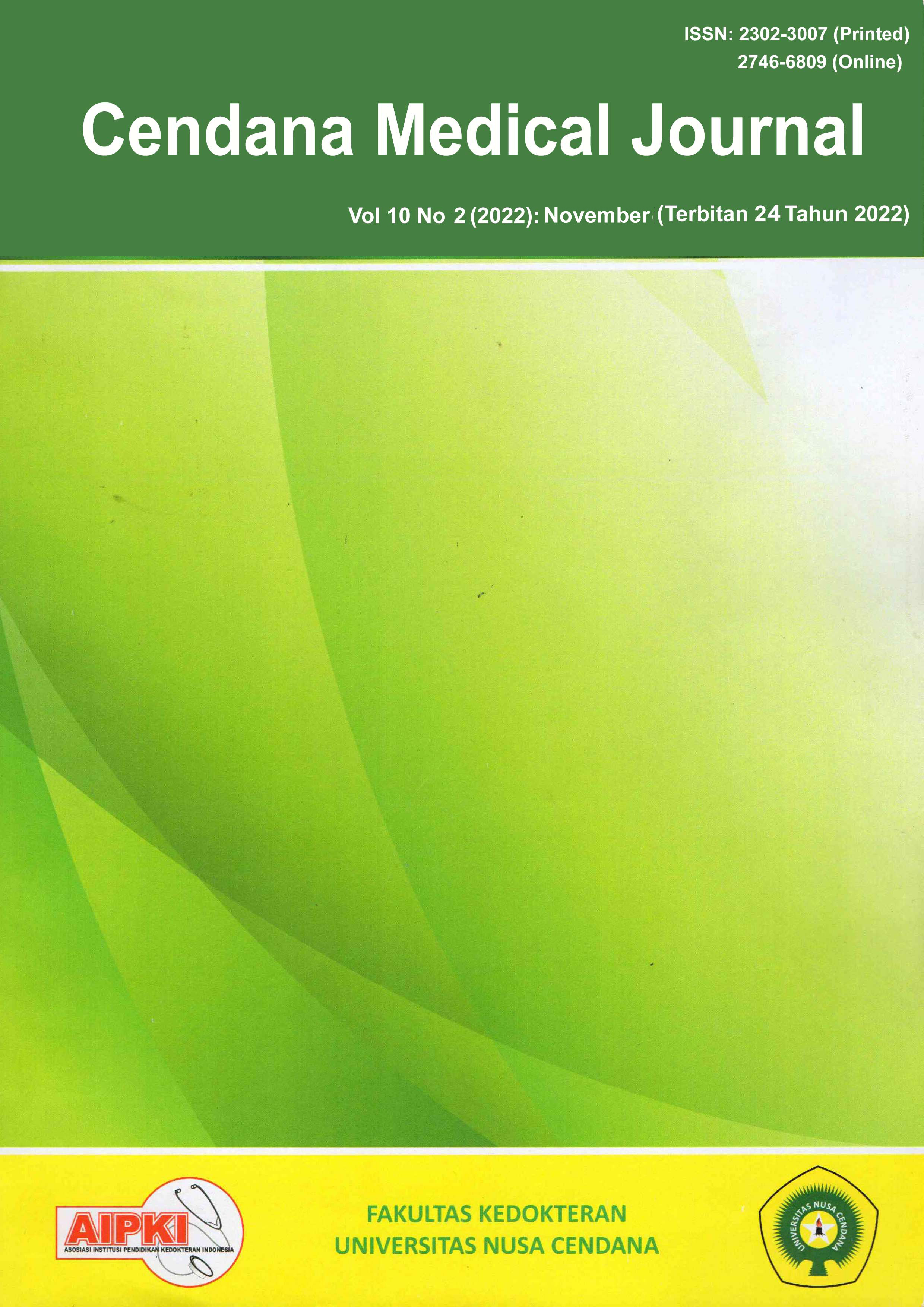Comparative Test Of Antibacterial Effectiveness Of Commercial Hand Washing Soap Made From Green Betel, Lime And Aloe Vera Against Staphylococcus Aureus Bacteria
Abstract
ABSTRACT
Background : Currently, there are many antibacterial soap products circulating in the community. To inhibit or kill bacteria, some soaps add an active substance that acts as an antimicrobial. However, repeated use of synthetic soap can cause skin irritation, dry skin, rashes and bacterial resistance. Some soap products add herbal ingredients to reduce side effects, including soap made from green betel, lime and aloe vera.
Objective : This study was conducted with the aim of knowing the differences in antibacterial inhibitory ability of hand soap products made from green betel, lime and aloe vera on the market against the growth of staphylococcus aureus bacteria. Methods : The type of research used is a Quasi Eksperimental disc diffusion method with a research design of the Posttest – only Nonequivalent control group design. The treatment group in this study consisted of a positive control (triclosan), a negative control (Sterile distilled water) and commercial handwashing soap made from green betel, lime and aloe vera with 5 repetitions for each group against the staphylococcus aureus bacteria. Data analysis used One Way Anova statistical test with 95% confidence level.
Result : Based on the measurement result, the largest inhibition zones were soap made from lime which was 26.4 mm, aloe vera 22.0 mm and green betel 18.8 mm which indicated that each experimental preparation had antibacterial potential and soap made from lime had a more effective inhibitory power in inhibiting the growth of staphylococcus aureus. Analysis of One Way Anova and Dunnet T3 tests obtained p result smaller than a = 0.05, whuch means that there is a significant difference in the mean diameter of the inhibition zone between the treatment groups. Conclusion : There is a significant difference in the antibacterial effectiveness of hand washing soap made from green betel, lime and aloe vera against staphylococcus aureus bacteria.
Keywords : Hand soap, Antibacterial, Inhibition, Staphylococcus aureus
Downloads
References
1. Pratami Ha, Apriliana E, Rukmono P. Identifikasi Mikroorganisme Pada Tangan Tenaga Medis Dan Paramedis Di Unit Perinatologi Rumah Sakit Abdul Moeloek Bandar Lampung. Med J Lampung Univ. 2013:85-94.
2. Harsanti, M. P. (2017). Hand Sanitizer Minyak Atsiri Dari Kulit Jeruk. Skripsi. Poltekkes Kemenkes Yogyakarta.
3. Park Jy, Seo Ks. Staphylococcus Aureus. Food Microbiol Fundam Front. Published Online 2019:555-584.
4. Taddesse Z, Tiruneh M, Gizachew M. Staphylococcus Aureus And Its Antimicrobial Susceptibility. Glob J Med Res C Microbiol Pathol. 2014;14(2):1-8.
5. Mulcahy Me, Mcloughlin Rm. Covid-19- Associated Staphylococcus Aureus Cavitating Pneumonia. Mbio. 2016;7(6):9-10. Doi:10.1128/Mbio.02068-16
6. Maryani C. 2013. Uji Aktivitas Antibakteri Ekstrak Jarak Tintir (Jatropha Multifida L.). Program Studi Biologi, Fakultas Keguruan Dan Ilmu Pendidikan, Universitas Sanata Dharma. Hal 39
7. Amrullah, A.A., Setiawan Dan D. Setyorini. 2017. Optimalisasi Kebersihan perseorangan/Personal Hygiene Bagi Masyarakat Pedesaan Di Desa Cipacing Kecamatan Jatinangor Kabupaten Sumedang. Jurnal Aplikasi Ipteks Untuk Masyarakat. 6(3):220-223
8. Kemenkes Republik Indonesia. Panduan Cuci Tangan Pakai Sabun. Kesehat Lingkung. 2020:20.
9. Acta, A., Vadhana, P., Singh, B.R., Bharadwaj, M., Singh, S.V., 2015. Pharmaceutica Emergence Of Herbal Antimicrobial Drug Resistance In Clinical Bacterial Isolates 6.
10. Gusviputri, A., Dkk. (2017). Pembuatan Sabun Dengan Lidah Buaya (Aloe Vera) Sebagai Antiseptik Alami.
11. Loho Tonny Dan Utami Lidya., 2007. Uji Efektifitas Antiseptik Triclosan 1% Terhadap Staphylococcus Aureus, Escherichia Coli, Enterococcus Faecalis Dan Pseudomonas Aeruginosa. 57(6): 171-178.
12. Patil, S.S., Yuvraj J.M., Dan Shrinivas .M., 2015, Formulation And Evaluation Of Herbal Hand Wash, International Journal Of Universal Pharmacy And Bio
13. Poolman, J.T. And Annaliesa S.A., 2018, Escherichia Coli And Staphylococcus Aureus: Leading Bacterial Pathogens Of Healthcare Associated Infections And Bacteremia In Older-Age Populations, Expert Review Of Vaccines, 17 (7): 1-12rowe, R.C, Paul J.S, Dan Marian, 2009.
14. Aiello, Susan E. The Merck Etinary Manual. Usa: Merck Sharp & Dohme Corp; 2012.
15. Abdul Razak, Aziz Djamal, Gusti Revilla. 2013. Uji Daya Hambat Air Perasan Buah Jeruk Nipis (Citrus Aurantifolia S.) Terhadap Pertumbuhan Bakteri Staphylococcus Aureus Secara In Vitro. Padang: Universitas Andalas, Fakultas Kedokteran
16. Berti,P. 2015. Daya Antibakteri Perasan Buah Lemon (Citrus Limon)Terhadap Porphyromonas Gingivalis Dominan Periodontitis . Naskah Publikasi. Fakultas Kedokteran Gigi. Universitas Muhammadiyah. Surakarta. 12 Hlm.
17. Rahayu, P. Winiati. 2000. Aktivitas Antimikroba Bumbu Masakan Tradisional Hasil Olahan Industri Terhadap Bakteri Patogen Dan Perusak. Vol 11(2). Buletin Teknologi Dan Industri Pangan.
18. Dewi, R., & Marniza, E. (2019). Aktivitas Antibakteri Gel Lidah Buaya Terhadap Staphylococcus Aureus. Jurnal Saintek Lahan Kering, 2(2622), 61–62.
19. Pelczar, J. Michael Dan E.C.S Chan (2006). Dasar-Dasar Mikrobiologi. Jakarta: Penerbit Universitas Indonesia (Ui_Press)
20. Obistioiu, D., Cristina, R. T., Schnerold, I., Chizzola, R., Stolze, K., Nichita, I. & Chiurciu, V. 2014. Chemical Characterization By Gc-Ms And Invitro Activity Candida Albicans Of Volatile Fractions Prepared From Artemisia Drcunculu
21. Kibret, B., Israel, A., Milkyas, E. & Demiss, A. 2018. Comparative Study Of The Antibacterial Activity Of Leaves Of Croton Macrostachyus And Aloe Vera. Advance In Life Science And Technology, 54: 22-28.
22. Cowan M.M. 2009. Plant Products As Antimicrobial Agents. Oxford: Miami University.
23. Darsana, I. G. O., Besung, I. N. K. & Mahatmi, H. 2012. Potensi Daun Binahong (Anredera Cordifolia) Dalam Menghambat Pertumbuhan Bakteri Escherichia Coli Secara In Vitro. Indonesia Medicus Veterinus. 1(3): 337-345.
24. Rahardjo, M, Koendhori, Eb, Setiawati Y. Uji Aktivitas Antibakteri Ekstrak Etanol Lidah Buaya (Aloe Vera) Terhadap Bakteri Staphylococcus Aureus. Jurnal Kedokteran Syiah Kuala. Vol17,(2) Pages: 65-70
25. Hamman, Jossias H. 2008. Composition And Applications Of Aloe Vera Leaf Gel. Molecules 13, 1599-1616.
26. Fani, M., And Kohanteb, J., 2012, Inhibitory Activity Of Aloe Vera Gel On Some Clinically Isolated Cariogenis And Periodontopathic Bacteria, Journal Of Oral Science,54(1):15-21.
27. Johnson Ba, Nunley Jr. Use Of Systemic Agents In The Treatment Of Acne Vulgaris. Virginia: Virginia Commonwealth University Medical College Of Virginia School Of Medicin. 2000.
28. Kemper Kj, Chiou V. Aloe Vera. Longwood Herbal Task Force. 1999.
29. Inayatullah S, (2012). Efek Ekstrak Daun Sirih Hijau (Piper Betle L.)Terhadap Pertumbuhan Bakteri Staphylococcus Aureus. Skripsi. Program Studi Pendidikan Dokter Fakultas Kedokteran Dan Ilmu Kesehatan.
30. Hermawan A, (2007). Pengaruh Ekstrak Daun Sirih (Piper Betle L.) Terhadap Pertumbuhan Staphylococcus Aureus Dan Escherichia Coli Dengan Metode Difusi Disk. Skripsi. Fakultas Kedokteran Hewan Universitas Airlangga.
31. Harapini, M., A. Agusta Dan R. D. Rahayu. (1996). Analisis Komponen Kimia Minyak Atsiri Dari Dua Macam Sirih (Daun Kuning Dan Hijau). Prosiding Simposium Nasional I Tumbuhan Obat Dan Aromatika.
32. Heyne K. Tumbuhan Berguna Indonesia Edisi 2. Jakarta: Departemen Kehutanan, 1987 : 950.
33. Maharani. Efek Hambat Berbagai Pasta Gigi Terhadap Pertumbuhan Streptococcus Mutans (Belum Dipublikasikan). 2012.
34. Pelczar, J. Michael Dan Chan, E. C. S., 1988. Dasar-Dasar Mikrobiologi 2. Penerbit Ui Press: Jakarta.
35. Pelczar, M.J., E.S.Chan. Dasar-Dasar Mikrobiologi Edisi Ke-2. Jakarta : Penerbit Universitas Indonesia. 1988.
36. Karmakar, M. And R. R. Ray. 2011. Current Trends In Research And Application Of Microbial Cellulases. Res. Journal Of Microbiology 6(1), 41-53.
37. Who, 2009. Who Guidelines On Hand Hygiene In Health Care.
38. Fda/Cfsan. Hand Hygiene In Retail & Food Service Establishments. Food Service Safety Fact Sheet. 2003.
39. Desmares, Catherine Dkk. Short Communication: Is Ethanol-Basedhandsanitizer Involved Inacutepancreatitis After Excessive Disinfection?An Evaluation With The Use Of Pbpk Model. Journal Of Toxicology. 2012.
40. Joseph R. Grubbs Jr.The Effects Of Triclosan Derivatives Against The Growth Of Staphylococcusaureus. 2008.
41. Salha H.M. Al-Zahrani And Afraa M. Baghdadi. Evaluation Of The Efficiencyof Non Alcoholichandgel Sanitizers Products As An Antibacterial. Natureand Science, 2012. Vol 10. 6; Hal. 2012.
Copyright (c) 2022 Cendana Medical Journal (CMJ)

This work is licensed under a Creative Commons Attribution-NonCommercial-NoDerivatives 4.0 International License.
Copyright Notice

This work is licensed under a Creative Commons Attribution 4.0 International License.

 Dania Ekasanti M. Seran(1*)
Dania Ekasanti M. Seran(1*)












